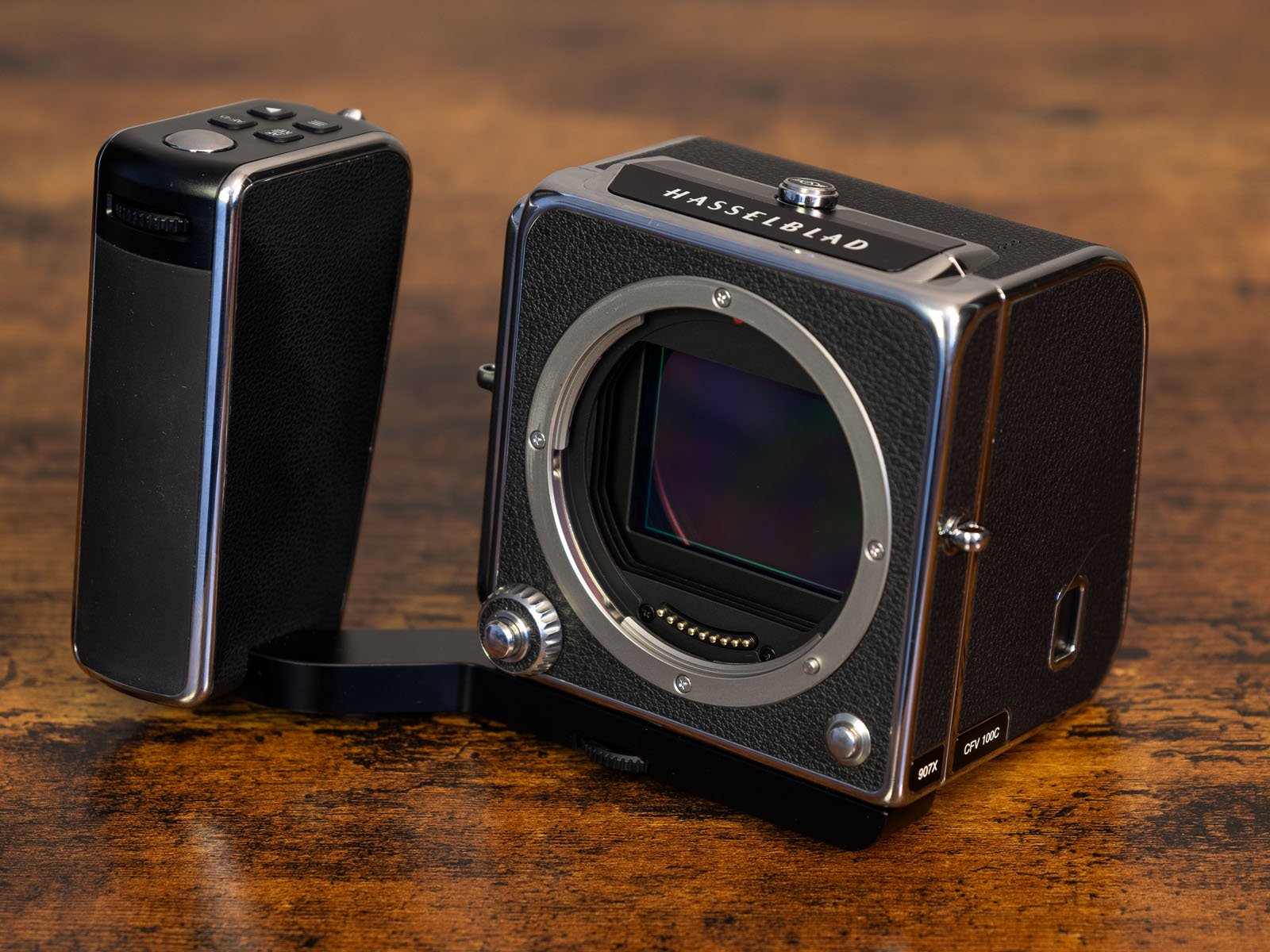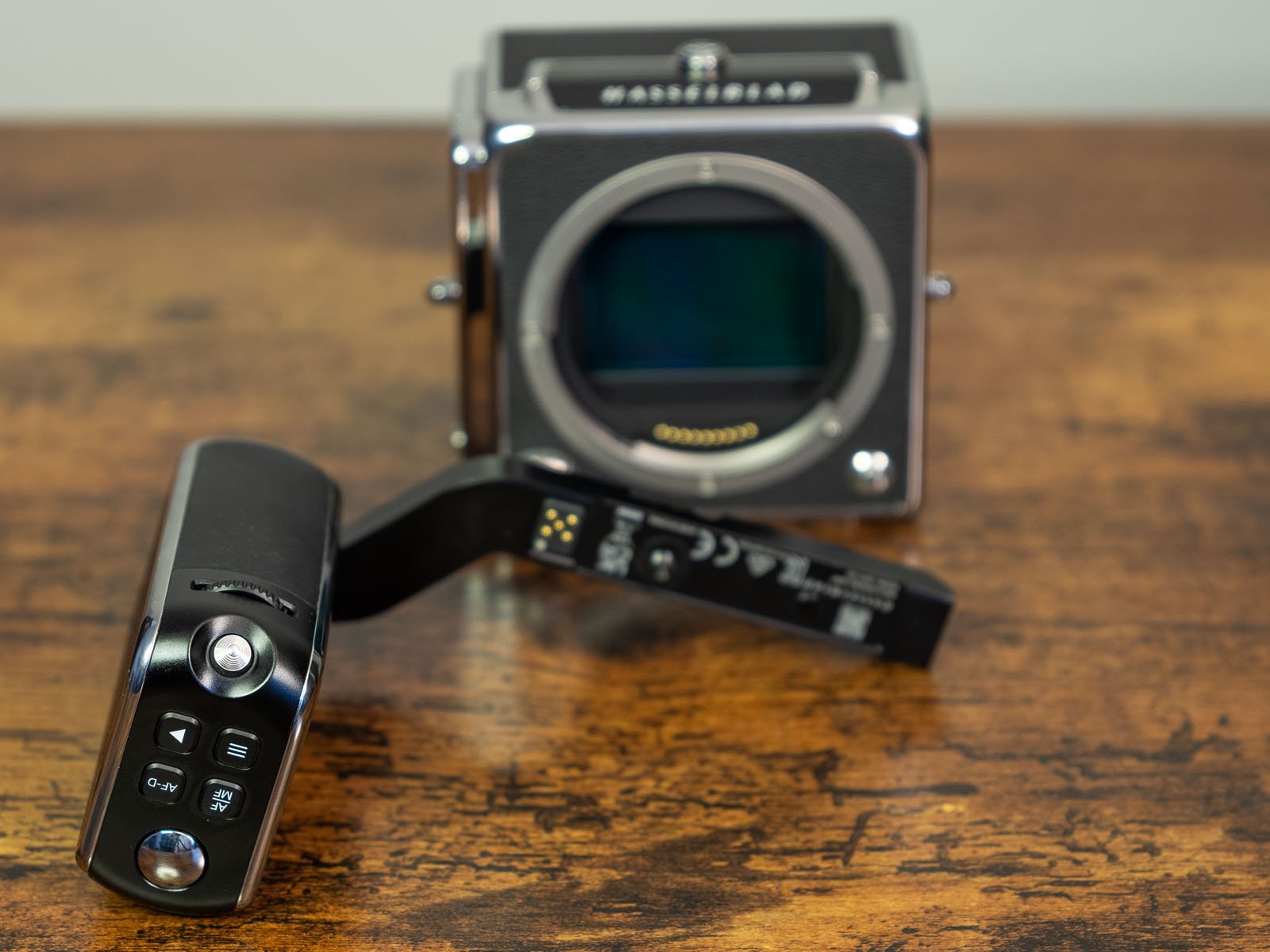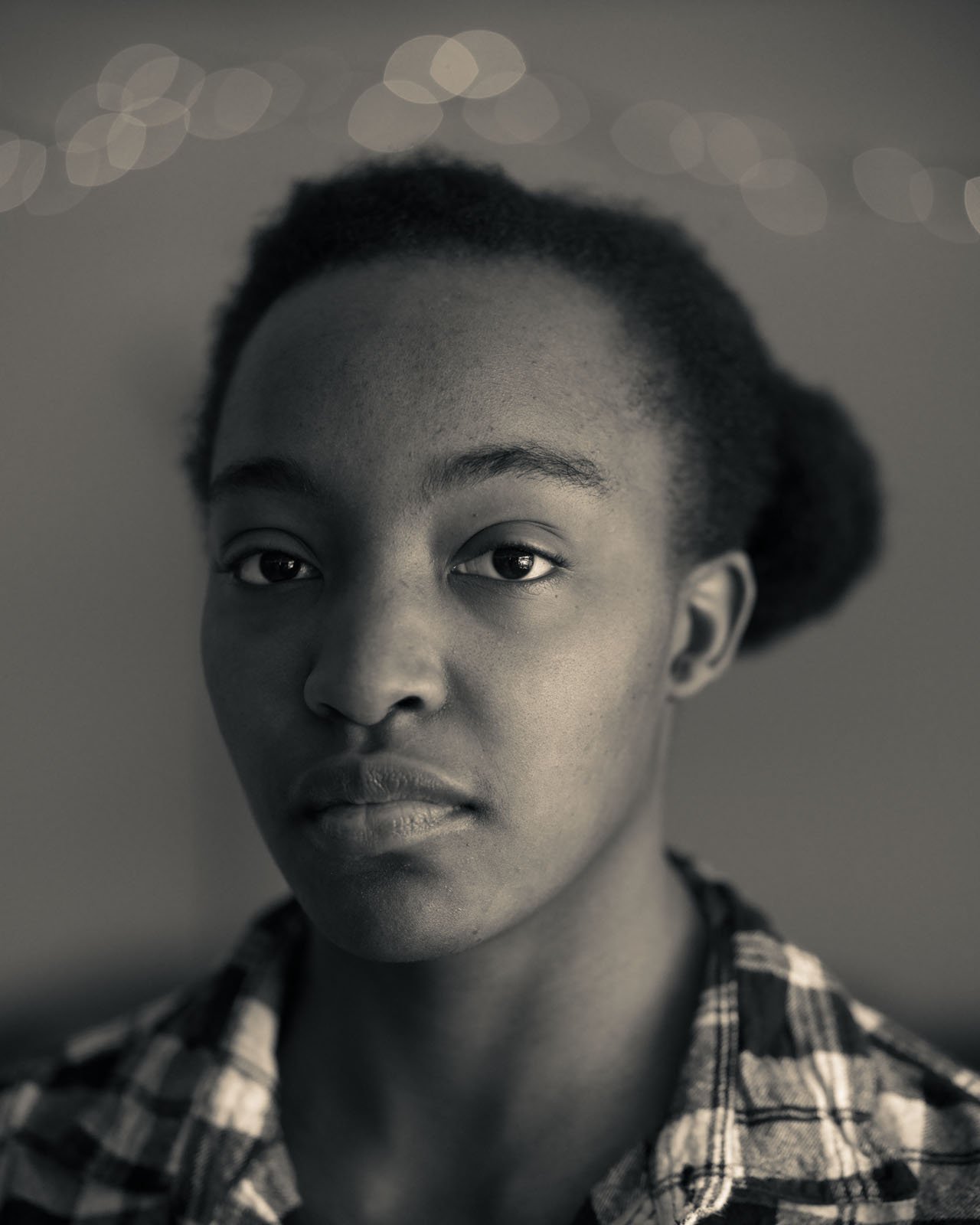The Hasselblad 907X CFV 100C is a fantastic, stylish, and — perhaps most importantly — charming camera kit. The camera and digital back combo honor Hasselblad’s illustrious analog past while incorporating the company’s most modern digital imaging technology.
Before properly diving into the review, there’s some vital context to add. The “camera,” as it were, is two separate components sold in a package.
There is the 907X, which is the camera body itself. It’s a thin metal frame with a lens mount, a shutter release, and basic electronics. It lacks many things a camera often has, like an image sensor, a battery, memory, a screen, etc. This is the same 907X camera that debuted alongside the 50-megapixel 50C image sensor in 2021.

The 907X camera body (or frame, really) is unchanged. However, Hasselblad has introduced the 907X and CFV 100C combination, which swaps out the 50-megapixel 50C digital back in favor of a new 100-megapixel CFV 100C back.
The introduction of this new CFV 100C back drives every available new feature and is the eyes and brain of the Hasselblad 907X experience. The 907X is the skeleton, while the CFV 100C digital back is everything else.
![]()
Hasselblad 907X CFV 100C: Stunning Vintage-Inspired Design
Now that we’ve gotten that out of the way, we can dive in at full speed. The 907X frame is fine. It does its job of acting as a suitable carapace for the new digital back.
The 907X’s front shutter release and dial are nice to have, especially if you don’t use the optional Hasselblad 907X Control Grip ($729). Without this optional grip, which adds quite a bit of bulk to the camera kit and includes physical controls, photographers must either use the digital back’s touchscreen to take photos or press the front shutter release. It’s a pretty old-school setup.

I almost exclusively shot with the Control Grip attached in my short time with the 907X and CFV 100C. Once secured, it feels very sturdy and stable, like it is built-in, even though it’s attached by a screw thread. The control grip has front and rear command dials, a shutter release, four function buttons, and a focus selector joystick. It turns the boxy 907X into a more typical camera, albeit strikingly different in appearance.
![]()
My only negative feedback about the control grip is that the autofocus selector joystick could be better. It’s far too easy to press it in when moving it along the X and Y axes, which causes the camera to zoom in on the focus point. It was a constant struggle. This was far from enough to get me to stop using it, but it’s still frustrating.
![]()
Now for the CFV 100C digital back. This attaches to the 907X body and sports a 3.2-inch TFT-type tilting touchscreen with 2.36 million dots. The display has soft locks at 40 and 90 degrees and is generally a sharp, vivid panel. The touchscreen functionality is reasonably responsive, and Hasselblad’s menus are intuitive and built from the ground up around touch.
Below the display are five buttons, which serve as menu, back, forward, playback, and power buttons in most situations. Long-pressing buttons (or touch elements) can sometimes bring up nested menu options, which didn’t take me long to get used to.
![]()
In fairness, I reviewed the X2D 100C back in my Imaging Resource days, so I’m used to Hasselblad’s menu system and setup. The CFV 100C is very similar to the X2D 100C in many ways, albeit with a small display and fewer physical controls.
The CFV 100C is also a lot like the CFV 50C. However, there are a few differences worth mentioning. For starters, the CFV 100C weighs 120 grams less than the CFV 50C, a significant weight reduction. The shed weight also comes with a slight slimming down, although that’s not noticeable (it’s a single millimeter smaller in one dimension). Nonetheless, the 907X and CFV 100C combination is the smallest and lightest high-resolution medium-format camera on the market.
![]()
The CFV 100C has 1TB of internal SSD storage, a single CFexpress Type B slot, and a USB-C slot that supports charging. It also has a hot shoe, which is something the CFV 50C lacked.
It doesn’t include a viewfinder, although users can add an optical one if they want — it’s $499. That’s not a typo, either; I meant “optical,” not optional, although it is also that. The Hasselblad 907X Optical Viewfinder comes with 21, 30, and 45mm frame lines and is just a see-thru bit of glass to offer photographers a different shooting experience. There’s also a new version of this viewfinder that includes 28, 38, and 55mm frame lines.
![]()
My review kit didn’t include the optical viewfinder, so I cannot speak to its quality or utility. However, our 907X 50C Review from 2021 includes some information about it.
Despite its quirks, I genuinely enjoyed shooting with the Hasselblad 907X and CFV 100C. It’s a beautiful camera that exudes class and craftsmanship.
![]()
Oh, and the digital back attaches to other Hasselblad cameras, including nearly every V System film camera dating back to the 1950s. How cool is that? The 907X and CFV 100C don’t just have an old-school cool factor; the kit is properly vintage-friendly.
Hasselblad 907X CFV 100C: Better Image Quality and Improved Autofocus
I shoot with a camera that has the same sensor as the original 907X and CFV 50C combination, so I know that it’s possible to extract remarkable image quality from that 50-megapixel image sensor, even if 50 megapixels seems like old news in the mirrorless medium-format space.
![]()
![]()
However, the jump to 100 megapixels is still remarkable. I’ve used the X2D 100C, which features the same backside-illuminated 100-megapixel CMOS sensor as the CFV 100C, so I knew what image quality to expect with the new digital back. Even still, it’s hard not to constantly zoom in and gawk at the images on the back of the camera. The level of detail and sharpness is incredible.
![]()
![]()
Hasselblad’s fantastic lenses have a lot to do with that, too, of course, and I had a few great primes to choose from, including the XCD 28P f/4, XCD 38V f/2.5, XCD 55V f/2.5, and XCD 90V f/2.5. The 90V is stunning, by the way, but that’s neither here nor there.
![]()
![]()
The CFV 100C captures 16-bit RAW files in single-shot mode, and the RAW files are exceptionally rich in detail and tonality and can be pushed very far during post-processing. It’s easy to recover shadow and highlight detail without disturbing the image quality.
![]()
![]()
At its base ISO of 64, the CFV 100C promises up to 15 stops of dynamic range. I put very little weight in what companies say about the dynamic range performance of their cameras, so let’s check out what the excellent William J. Claff’s testing shows at Photons to Photos.
Claff has tested the CFV 50C and X2D 100C, providing everything we need. The 100-megapixel chip’s native ISO of 64 is lower than the 50-megapixel sensor’s base ISO of 100, for starters, which helps deliver a higher maximum dynamic range. The 100-megapixel sensor tops out at 12.32 EV in Claff’s testing, besting the 50-megapixel’s maximum of 11.7 EV. The two cameras are similar at ISO 100, although the 100MP sensor pulls back ahead at ISO 200 and maintains a roughly half-stop lead throughout the rest of the ISO range.
![]()
I am curious how Hasselblad arrived at 15 stops of dynamic range. However, the X2D 100C — and thus the CFV 100C — is still highly performant. It offers a dynamic range beyond any full-frame camera that does not use a special multi-shot. Larger medium-format sensors, like the Phase One IQ4 150MP and IQ3 100MP, still best the smaller medium-format X2D 100C and GFX, but that’s to be expected. There’s no substitute for bigger image sensors.
![]()
The CFV 100C also offers a higher maximum native ISO (12,800 versus 3200) than its predecessor. Although a medium-format camera’s main advantage over full-frame systems — the image quality — is undercut a bit by increasing the ISO, the CFV 100C is still extremely good at high ISO settings. The quality of the noise is also pleasant, offering a fine-grain, consistent look. Not all noise is equal, and the CFV 100C’s noise is perfectly acceptable.
![]()
Another benefit of the jump to 100 megapixels is that there’s a lot more flexibility available with cropping. The CFV 100C offers numerous in-camera crop modes, and they are respected during post-processing even though the entire image area is available if you change your mind later. I love getting creative with different aspect ratios in the field, so it’s nice that taking advantage of them doesn’t mean I’ll end up with a small image file. 100 megapixels is a lot to play with.
![]()
![]()
Overall, the CFV 100C’s image quality is fantastic; I have no complaints at all about the image sensor. The color depth, resolution, and dynamic range are exceptional at low ISO settings. Even at higher ISO settings, image quality remains impressive. Like the Hasselblad X2D 100C and the Fujifilm GFX 100-series cameras, the CFV 100C delivers outstanding image quality that surpasses anything in a full-frame camera system.
![]()
Hasselblad 907X CFV 100C: So What’s the Catch? Performance.
There’s no doubt that a full-frame camera cannot match the Hasselblad 907X CFV 100C in terms of image quality. However, many, if not all, full-frame cameras offer better autofocus and overall performance.
![]()
The CFV 100C benefits from the same autofocus advances made in the X2D 100C, namely a 294-point phase-detect autofocus system that covers quite a bit of the image sensor. It is better than the contrast-detect autofocus system of Hasselblad’s 50-megapixel offerings. However, autofocus is still not as quick as what photographers can find on full-frame cameras, especially ones that approach the 907X CFV 100C’s $8,200 price tag.
![]()
The CFV 100C has face detection — but not eye detection — and autofocus is generally accurate overall. But it all feels relatively lacking even at the cutting edge of Hasselblad’s medium-format autofocus technology.

I don’t expect the 907X CFV 100C to be an action camera; that’s like using a screwdriver to hammer in nails. But I do wish that everything was just a bit snappier. It’s enjoyable to walk around with the 907X CFV 100C, but the joy is undermined by sluggish autofocus performance. The camera also lacks in-body image stabilization, which the X2D 100C has, so that’s another slight damper.
![]()
If you wanted to shoot at the CFV 100C’s max speed of 3.3 frames per second — I wouldn’t — the camera doesn’t have continuous autofocus of any sort. So again, this is not a camera for photographing action. You’ll be sorely disappointed if you try to use it that way.
![]()
Photography With a Soul
If I’m being objective, the stylish Hasselblad 907X CFV 100C has a lot of downsides as an overall photographic tool. The image quality is terrific, but that’s not unique to the 907X CFV 100C in Hasselblad’s lineup.
However, everything else about the camera is not entirely up to snuff. The autofocus is bad, the lack of an EVF is limiting, and not having in-body image stabilization makes the camera a bit fussy when out in the real world, where a tripod is only sometimes an option.
![]()
I know all that and felt it firsthand, but I’ll be damned if I still didn’t love my time with the Hasselblad 907X CFV 100C. It has character. That’s sometimes a euphemism for something being annoying or frustrating, and the 907X CFV 100C has all the makings of a camera that genuinely would be tedious to use, but somehow, it all clicks.
It has a soul, and when used in the relatively limited situations in which it can succeed, it truly sings.
![]()
Are There Alternatives?
There are quite a few of them. The Hasselblad X2D 100C offers the same excellent image quality in a more versatile and flexible “normal camera” package. It also has IBIS and an EVF, which matters.
If you’re not tied to the Hasselblad system, there’s also the Fujifilm GFX 100 II, or for just $4,400, the GFX 100S. The GFX system doesn’t have leaf-shutter lenses, so that’s a potential downside. Still, the Fujinon GF lenses are generally more versatile than Hasselblad’s offerings, thanks mainly to numerous great zoom lenses.
Suppose someone wants excellent image quality but doesn’t necessarily need the best possible. In that case, there are also high-resolution full-frame mirrorless cameras, like the Sony a7R V. When using its somewhat frustrating multi-shot pixel-shift mode, the image quality gap is reduced.
![]()
Should You Buy It?
“Should” is such a challenging word sometimes. No, you shouldn’t buy the Hasselblad 907X CFV 100C unless you have a bunch of vintage Hasselblad gear you want to use in the digital age.
But, on the other hand, you may very well want to buy the 907X CFV 100C, and there’s nothing wrong with that. You can get more features and performance for less, but you’ll be hard-pressed to find a camera as inspirationally fun.
